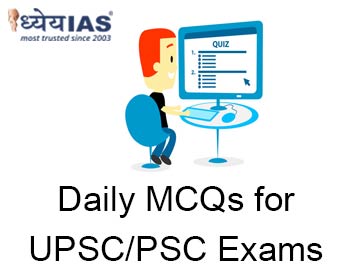Home > Daily-mcqs
Daily-mcqs 23 May 2025

Q1:
Which of the following correctly explains the function of neurotrophins?
A: They digest waste in the brain.
B: They promote neuron growth, survival, and plasticity.
C: They act as immune suppressors.
D: They regulate blood pressure in the brain.
Answer: B
Explanation:
Neurotrophins are proteins that are essential for the development, survival, and proper functioning of neurons. They help in promoting neuronal growth, support the survival of nerve cells, and improve synaptic plasticity, which is crucial for memory and learning. However, they degrade quickly and have poor penetration into the brain, limiting their therapeutic use. That’s why synthetic alternatives like peptidomimetics are being developed.
Q2:
The term "satellite population" in wildlife conservation refers to:
A: Animals tracked using satellite technology
B: Animals living in secondary habitats outside core protected areas
C: Populations that migrate between countries
D: Captive animals kept for breeding
Answer: B
Explanation:
A satellite population refers to wild animals that live outside traditional core protected zones, often in human-dominated landscapes. In the case of Asiatic lions, nearly 497 out of 891 lions now live in satellite regions like Jetpur and Barda. This indicates natural dispersal and a need for broader conservation beyond just national parks.
Q3:
Which of the following platforms feed data into the Financial Fraud Risk Indicator (FRI) classification system? Select the correct answer using the code below:
A: 1 and 2 only
B: 1, 2, and 4 only
C: 2, 3, and 4 only
D: 1, 2, 3, and 4
Answer: B
Explanation:
The FRI system relies on data inputs from the National Cybercrime Reporting Portal (NCRP), DoT’s Chakshu platform, and banks/financial institutions. It does not use data from the Aadhaar database for classification. This combined input allows for accurate identification of fraud-prone numbers and enables real-time fraud risk analysis for digital transactions.
Q4:
Which of the following are included in the five pillars of the ULLAS initiative? Select the correct answer using the code below:
A: 1 and 2 only
B: 1, 2, and 4 only
C: 1, 3, and 4 only
D: 1, 2, 3, and 4
Answer: B
Explanation:
The five core pillars of ULLAS are:
Financial literacy is important but is part of Mizoram’s future plans, not a core pillar of ULLAS. The correct answer is therefore 1, 2, and 4. These pillars aim to create a well-rounded learning ecosystem for adults across India.
Q5:
According to the K. Veeraswami v. Union of India (1991) ruling, which of the following is required before registering an FIR against a sitting High Court or Supreme Court judge?
A: Approval of the President of India
B: Approval of the Prime Minister
C: Approval of the Chief Justice of India
D: Approval of the Attorney General of India
Answer: C
Explanation:
In the K. Veeraswami case (1991), the Supreme Court ruled that no FIR or criminal case can be initiated against a sitting High Court or Supreme Court judge without the prior approval of the Chief Justice of India (CJI). This rule was established to protect judicial independence and to prevent the misuse of law against judges. It ensures that only credible and serious allegations are pursued, keeping frivolous or politically motivated cases in check.
Q6:
Consider the following statements regarding Lassa fever: Which of the above statements is/are correct?
A: 1 and 2 only
B: 2 only
C: 1 and 3 only
D: 2 and 3 only
Answer: B
Explanation:
Lassa fever is caused by a virus, not bacteria, so statement 1 is incorrect. It is transmitted to humans through contact with food or surfaces contaminated by the urine or feces of infected multimammate rats (Mastomys natalensis). Statement 2 is correct. Human-to-human transmission is rare and occurs through direct contact with bodily fluids of infected individuals, not airborne, so statement 3 is also incorrect.
Q7:
With reference to the JN.1 variant of SARS-CoV-2, consider the following statements: Which of the above statements is/are correct?
A: 1 and 3 only
B: 2 and 3 only
C: 1 only
D: 1, 2 and 3
Answer: A
Explanation:
JN.1 is not a new strain, but a sub-lineage of Omicron BA.2.86, making statement 1 correct and 2 incorrect. It has several spike protein mutations (around 30) that give it the ability to partially evade immune responses, including in vaccinated people. This means it can spread even among previously infected or vaccinated individuals, which makes statement 3 also correct.
Q8:
Consider the following Assertion/Reason and choose from the following options: Assertion (A): The Environmental Impact Assessment (EIA) process helps prevent environmental damage before a project begins. Options:
Reason (R): EIA requires that all industrial projects in India conduct post-construction environmental audits.
A: Both A and R are true, and R is the correct explanation of A.
B: Both A and R are true, but R is not the correct explanation of A.
C: A is true, but R is false.
D: A is false, but R is true.
Answer: C
Explanation:
EIA is a preventive tool. It helps authorities understand and avoid environmental harm before a project begins. However, the Reason is incorrect—EIA does not require post-construction audits as a default. Instead, it focuses on pre-construction approvals and includes a public hearing, mitigation plans, and environmental monitoring frameworks. Post-facto regularization has been ruled unconstitutional.